Live on the homepage now!
Reader Supported News
I was a firearms exec for years. The industry used to adhere to self-imposed rules and norms – until gun makers and lobby groups like the NRA realized fear and extremism sold more guns
Eventually, their message becomes almost universal: Something is horribly broken in a country that allows troubled young men to arm themselves to the teeth and kill innocent people – especially young children. Social media explodes, expressing a version of the shock that the first lady, Jill Biden, expressed after the murders in Uvalde – “Stunned. Angry. Heartbroken.”
I too am angry and heartbroken. But I am not stunned, and I don’t believe anything is broken. The truth is that Americans now live within an escalating system of radicalized gun tragedy that is working exactly as expected.
I know. For more than two decades, I worked in the highest levels of the firearms industry. I spent my career working to hold on to the principles of responsible gun ownership and fighting against the very predictable results of increasing extremism and the pursuit of profit above all else.
I wrote my book Gunfight about the truth of what the industry has become and about my life fighting it from the inside. Today I’m a senior adviser to the gun violence prevention group founded by former congresswoman Gabby Giffords – not a career path I thought I’d have when I first started out in the firearms industry, but one that felt very necessary to me given what I experienced.
For the first few years of my career, which started in 1995, the industry adhered to self-imposed rules and norms – such as restricting tactical gear like that worn by the Buffalo and Uvalde shooters to the law enforcement and military sections of trade shows. Even up until about 15 years ago, self-imposed policies like this were strictly enforced by the industry’s own trade association, the National Shooting Sports Foundation (NSSF). Industry norms prohibited displaying tactical gear, certain marketing campaigns or incendiary firearms names, for fear of what might spread throughout the country.
But as the increasing vitriol of the National Rifle Association (NRA) proved politically effective, some in the gun business realized this messaging could be adopted by the firearms industry to sell more guns. All that was required for success was a dedication to frighteningly dangerous rhetoric and increasingly powerful weaponry. Cultural norms and responsibility would have to go.
The extreme risks and likely outcomes of such an experiment seemed obvious to me and to others. I refused to join the growing tactical market and worked to weaken the NRA behind the scenes. And I wasn’t the only one.
A number of other people in the industry sounded their own alarms about the impacts of “terrorist rifles” and a nation with unlimited gun sales and insufficient responsibility. Those warnings resulted in the quick and very public loss of careers at the hands of the NRA and its growing radicalized troll army.
Everyone else got the message. Speaking up for responsibility was not to be tolerated. Unpleasantries like radicalized young men with too many guns were to be treated like diffuse pollution that could be dealt with by someone downstream. Even when unspeakable tragedies, such as the murders at Sandy Hook, were linked directly to shockingly irresponsible marketing campaigns that promised a metaphorical “man card” to any young man who purchased an AR-15, the NSSF opted to look the other way.
For years, the NSSF worked behind the scenes to criticize and marginalize people like me who spoke up. Today the organization openly attacks anyone who speaks out in support of gun safety. But it has nothing to say about Kyle Rittenhouse or armed men menacing the Michigan capital. So far there is silence from the NSSF and the NRA on the 10 Black Americans murdered in Buffalo and the 19 children and two teachers murdered in Uvalde.
The NSSF helped craft a new world of gun lobby extremism in which profits are all that matter. With the election of America’s first Black president, the lobby embraced conspiracy-mongering, racism and fear campaigns. Gun sales soared from less than 8m guns in 2008 to more than 16m in 2016.
In 2016, the firearms industry was all-in on Donald Trump and even piped his 2017 American Carnage inauguration speech throughout the industry trade show like a religious ceremony. The industry celebrated because Trump was the perfect salesman for more guns. This system was simply being pushed to its next stage.
This Friday, Trump is scheduled to speak at the annual NRA convention in Houston – less than 300 miles from Uvalde. The convention hall will be full of NSSF industry members lining up to court Trump and his frenzied fans. The system continues to work just as it was designed by the NRA and NSSF; from their point of view, nothing about it is broken.
There is a reason why troubled 18-year-olds can buy assault rifles, body armor and high-capacity magazines. There is a reason why racism, conspiracies and increasingly dangerous idolatry infect parts of our country, and federal gun legislation has stalled time and time again. It’s the gun lobby – the NRA, the NSSF and the politicians who are frightened of them.
The horrific murders of second- and third-graders are part of that system. It’s time to rebuild it. We can all be safer from gun violence if we’re willing to stand up to the gun lobby and the politicians who champion their dangerous extremism in pursuit of profits.
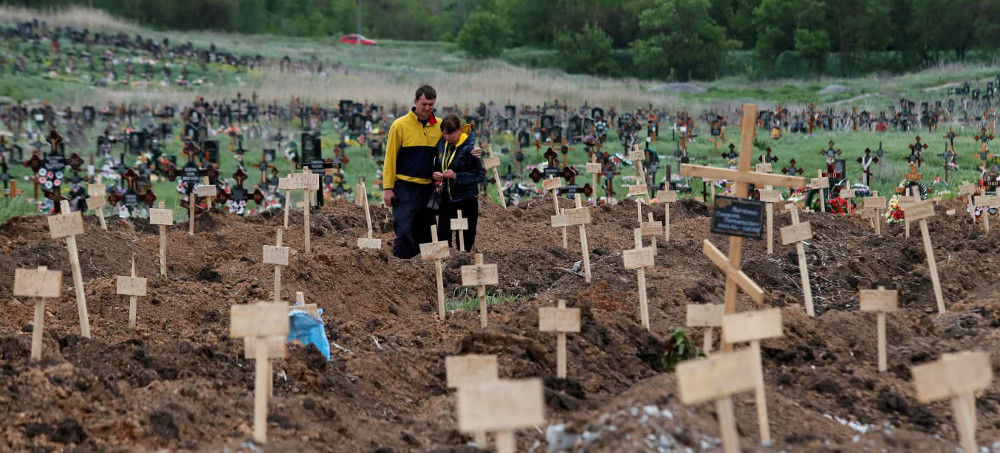 Petro Andryushchenko, an adviser to the mayor, said the discovery of Russia's indiscriminate aggression likely won't be the last. (photo: Alexander Ermochenko/Reuters)
Petro Andryushchenko, an adviser to the mayor, said the discovery of Russia's indiscriminate aggression likely won't be the last. (photo: Alexander Ermochenko/Reuters)
Petro Andryushchenko, an adviser to the mayor, said the discovery of Russia’s indiscriminate aggression likely won’t be the last.
It is unclear how many were killed when the building came down during the beginning of the three-month-old war, or if they died of starvation or from injuries as they tried to seek shelter. There were no survivors, he said. Just piles of bodies.
“The city has turned into a continuous cemetery,” Adryushchenko wrote in an online post, adding that a makeshift morgue had been set up to process the recently discovered remains.
The strategic port city was an early and constant focus of Russian aggression that ended a week ago—after 2,500 Ukrainian fighters gave up their fight to hold the Azovstal Steel Works factory and reluctantly turned themselves over to Russian troops. Russia controls the port city now, but uses Ukrainian civilians to carry out cleanup efforts from their brutal bombardment.
Prior to the war, some 450,000 people lived in the pretty port town. Now around 100,000 remain, according to Ukrainian foreign ministry estimates. Many of those are living in unhygenic conditions with limited food and clean water. Most have no plumbing, heat, or electricity.
Ukraine authorities say at least 21,000 people have died in Mariupol alone. Some were killed in a strike of a maternity ward, and at least 600 are estimated to have died when Russia bombed a theater clearly marked as a shelter for children. Russian troops stand accused of cremating many of the corpses, likely to hide evidence of war crimes. Other victims have been buried in gardens, parks, and ditches in graves marked with wooden crosses.
Russian forces, which have encountered heavy losses across the country, are focusing much of their might now on the Luhansk region of Donbas, which is one of the few areas in the east of the country still under Ukrainian control. Ukraine President Volodymyr Zelensky accused Russia of waging a “total war” to “inflict as much death and destruction as possible,” during his regular address Tuesday evening. “Indeed, there has not been such a war on the European continent for 77 years,” Zelensky said. “Practically the full might of the Russian army, whatever they have left, is being thrown at the offensive there.”
Meanwhile, hope glimmers as liberated cities like Kharkiv come back to life. The Associated Press reports that residents in Ukraine’s second largest city are returning home, many waiting in lines without fear of being bombed to collect rations of staples like flour and sugar.
Negotiations between the two nations have largely stalled with Zelensky telling a breakfast meeting at the World Economic Forum in Davis that he would only speak to Russian President Vladimir Putin if he comes back to the current world.
“Once the president is prepared to leave his bubble of this alternative reality into the real world and talk to us, understand that a lot of people are being killed, including civilians, perhaps then will he understand that we should start talking and should put the end to this war that he launched, his country is waging against us,” Zelensky said Wednesday morning, adding he would like to meet Putin face-to-face “with no intermediaries, no brokers.”
 The bodies of many dead Russian soldiers abandoned in areas around Kyiv. (photo: BBC)
The bodies of many dead Russian soldiers abandoned in areas around Kyiv. (photo: BBC)
When their dogs started digging insistently at a spot in the woods, villagers in Zavalivka called in the authorities.
They uncovered a man's body, face down with his legs oddly twisted beneath him. It was clear from his uniform that he was a Russian soldier.
Weeks after they failed to seize Ukraine's capital, the remains of Russian troops are still being discovered in and around the villages they passed through or occupied near the capital, Kyiv. But Ukraine says Russia shows little interest in getting them back.
From the grave in the woods, the body was removed to a refrigerated train on the outskirts of Kyiv that now operates as a mobile morgue for the Russian dead.
The white plastic sacks are marked with numbers rather than names and there were at least 137 stacked inside two carriages on the day we visited.
The Ukrainians attempt to identify the dead: on the body just brought in, the forensics team turned up two bank cards, as well as badges for a Russian motorised rifle brigade.
"At least this one has a chance of getting home," the man in charge announced, displaying the finds, including a soiled fragment of T-shirt printed with the Army of Russia logo.
Moments later, I confirmed that the man I had just seen exhumed had been a young, married soldier from Siberia. Next to his body bag, a carefully posed black-and-white photograph from his social media profile stared out from my phone.
Russia has a proud slogan: "We don't abandon our own." It's a big part of President Vladimir Putin's supposed justification for invading Ukraine, where he falsely claimed Russian-speakers needed protection.
That pledge appears not to apply so much to Russia's own soldiers.
"The bodies we've found show they treat people as rubbish, as cannon fodder," Col Volodymyr Liamzin told the BBC. "They don't need their soldiers. They throw them here, retreat - and leave the bodies."
We don't actually know how the young soldier in the woods came to be abandoned. The villagers in Zavalivka say they were mostly hiding in their cellars from shelling at the time - they assume he was injured and got lost as his unit was forced to retreat.
From what we've learned of the Russian troops fighting around Kyiv, many were young and inexperienced. It's likely they were fleeing under fire.
"We did do one swap," Col Liamzin says, explaining that the Russian side provided a shortlist of the dead soldiers it wanted returned.
"We're ready to give them all back, we want our own dead returned too. We knock on every door there is, but there is no response, no dialogue," the colonel says.
The delay in collecting bodies isn't unique to Russia.
Neither side in this war is open about the number of casualties suffered. We've spoken to several Ukrainian families who say their own government has been less than helpful in recovering the remains of Ukrainian soldiers from the battlefield.
One woman, who was told of her husband's death by the men in his unit, said she had been trying to recover his body for almost three months.
But the Russian dead are being discovered here all the time.
Just up the road from Zavalivka in Sytnyaky, the village elder told us at least 10 Russian soldiers were killed and left behind in March, probably more.
Their column was ambushed after they lost their way: the locals had removed and switched the traffic signs.
The battle was fierce. What was once a roadside restaurant at the spot is now a heap of rubble, a bit of wall and a giant aquarium that somehow survived the assault.
Leaflets in the ruins call on Russian soldiers to surrender and save their lives, and spare the blood of Ukrainian children.
The village elder says he and others buried the Russians after the battle "for sanitary reasons". When I look quizzical, he says most were blown to pieces.
He wasn't allowed to show us the graves: they constitute a crime scene until Col Liamzin's team can get round to visiting and exhuming the site. But his dig-list is already long.
A local man planting beetroot confirms that the Russians were killed along the main road.
"It's not humane to abandon a soldier, not to bury them," Mikola says, leaning on his spade. His own son is in Ukraine's army.
"My wife felt sorry for the Russians at first, but then we found out what they did here," he adds, referring to the shooting of unarmed civilians in places like Bucha and Irpin.
"No-one feels sorry for the Russians after that."
The burned wrecks of Russian tanks still line all the main roads into Kyiv. Every few seconds, cars stop and families spill out to take photographs, children clambering over the top.
It seems somehow cathartic. The other day, I watched a man working out by lifting a tank barrel up and down, over his head, as though he was doing weights.
But that same day, just a few steps across the road, we spotted human remains on a scorched patch of verge - a charred piece of spine and a fragment of foot - and a sweet, deathly smell when the wind dropped. It was most likely one of the men killed in one of the nearby tanks.
So the refrigerated train in Kyiv is still filling up, and there are more in other cities close to the fighting. For the Ukrainian military who recover and store the bodies, there is little sympathy: the dead are enemy soldiers - invaders.
But in Russia, someone, somewhere must be looking for each one of them.
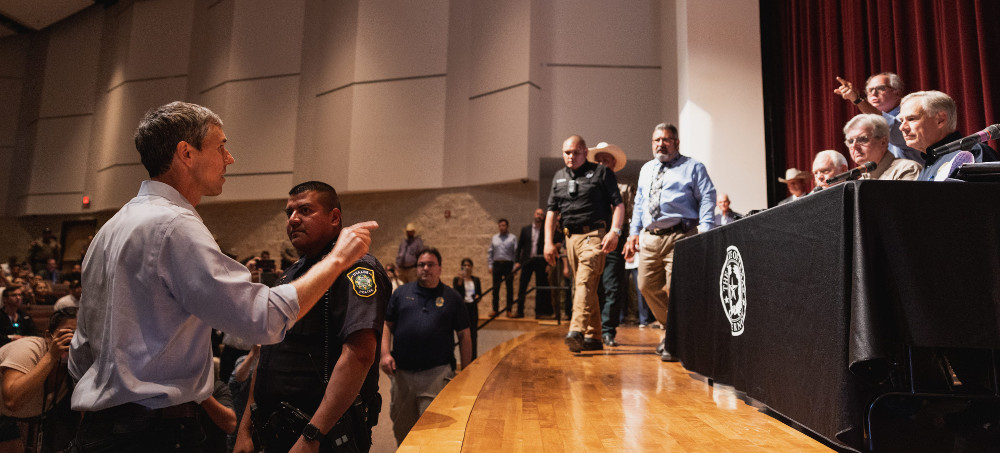 Democratic gubernatorial candidate Beto O'Rourke interrupts a news conference held by Texas Gov. Greg Abbott on May 25, 2022, in Uvalde, Texas. (photo: AP)
Democratic gubernatorial candidate Beto O'Rourke interrupts a news conference held by Texas Gov. Greg Abbott on May 25, 2022, in Uvalde, Texas. (photo: AP)
Gubernatorial candidate and former U.S. Rep. Beto O’Rourke showed up at news conference about the horrific Robb Elementary School shooting and confronted Gov. Greg Abbott. He busted right into the middle of the briefing – decorum be damned – and said what a whole lot of Americans would like to say: “You’re doing nothing. You’re offering us nothing.”
He was, of course, shouted down.
One man on the stage angrily hollered: “I can’t believe you’re a sick son of a bitch who would come to a deal like this to make a political issue.”
He was whisked away with urgency, but not before creating a moment that resonated with those of us who know full well that politicians at that press conference – like Abbott and Republican Sen. Ted Cruz – have bent over backward to loosen or block gun regulations and fight against things like Medicaid expansion, which would give people greater access to mental health care. Politicians who themselves routinely pull outrageous political stunts – like Cruz cooking bacon on a hot rifle or Abbott putting migrants on buses to Washington, D.C. – to make a point.
Necessary urgency for the moment
Was O’Rourke’s viral outburst also political stunt? Absolutely.
Was it wrong to do that at a news conference the day after at least 19 children and two adults were gunned down at an elementary school? Some will say it absolutely was, and I can understand that perspective. But I was glad to see it, particularly on a day when Democratic Senate Judiciary Chairman Dick Durbin told reporters that no gun control measures would be taken up in the Senate until after Memorial Day. As if now is not the time for a bit of urgency.
Why do mass shootings keep happening? Because this is what we've allowed America to become.
We only made it 10 days after the Buffalo grocery store massacre in New York before the Uvalde elementary school shooting happened in Texas. And Democrats are comfortable saying, “Well, we’ve got the long weekend coming up, so we’ll just hold off on things for now”?
I’ll take O’Rourke making a righteous scene at a press conference over that ineffectual frittering any day.
My son never came home from Sandy Hook. My heart bleeds for Texas as I relive Dylan's murder.
Later, outside the event, O’Rourke continued talking about Abbott’s gun policies, his voice rising to a yell: “He has refused to support a ban on AR-15s and AK-47s. This 18-year-old who just turned 18 bought an AR-15 (style) and took it into an elementary school and shot kids in the face and killed them. Why are we letting this happen in this country? Why is this happening in this state? Year after year, city after city. This is on all of us if we do not do something.”
My response to that was: Yes. Thank you. More of this, please. More of this passion. More of this in-your-face resistance to people who respond to mass shootings by denying that America has a serious gun problem.
Could we prioritize lives over picnics?
We aren’t going to stop all gun violence. Ever. But we know full well the reasonable and broadly popular steps that can be taken to help make Americans, and American children most importantly, safer: universal background checks; an assault rifle ban; a federal red flag law; a liability insurance requirement for gun owners; a ban on high-capacity magazines.
Why won't most Republicans try to fix the gun problem? Will voters ever care?
I’d love to live in a country where we could all sit down and hash this whole gun thing out like reasonable people. But we don’t live in that country, and I don’t imagine we will as long as the National Rifle Association is lining the pockets of politicians who gladly blame mass shootings on everything but guns.
Like it or not, for people on my side of the fence, O’Rourke’s outburst was a refreshing display of chutzpah.
We need leaders unafraid to take a stand, not leaders who figure they can worry about such things after they’ve enjoyed their Memorial Day picnics.
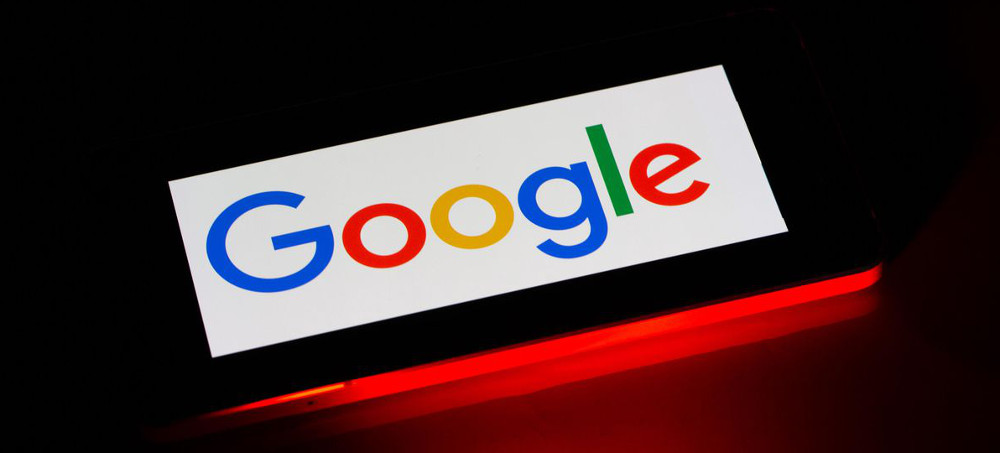 Without changes, Android's location system could become 'a tool for far-right extremists,' members of Congress say. (photo: iStock)
Without changes, Android's location system could become 'a tool for far-right extremists,' members of Congress say. (photo: iStock)
Without changes, Android’s location system could become ‘a tool for far-right extremists,’ members of Congress say
The request was made in a letter sent to Google CEO Sundar Pichai on Tuesday by members of the House and Senate, led by Senator Ron Wyden (D-OR) and including well-known progressive representatives such as Ayanna Pressley, Elizabeth Warren, Bernie Sanders, and Alexandria Ocasio-Cortez.
“We believe that abortion is health care,” the letter states. “We will fight tooth and nail to ensure that it remains recognized as a fundamental right, and that all people in the United States have control over their own bodies. That said, we are concerned that, in a world in which abortion could be made illegal, Google’s current practice of collecting and retaining extensive records of cell phone location data will allow it to become a tool for far-right extremists looking to crack down on people seeking reproductive health care.”
The letter specifically references geofence warrants, a controversial technique in which law enforcement agencies request that tech companies provide data on all mobile phones that passed through a geographically defined area in a certain time period. Geofence warrants have been criticized for their use in the investigation of protesters during Black Lives Matter demonstrations, and their use has grown dramatically in recent years: data released by Google showed a pronounced spike from 2018 to 2020.
Crucially, geofence data is only available after a court-issued warrant — but with more than 20 states preparing to outlaw abortion as soon as Roe v. Wade is overturned, it’s increasingly plausible that such a warrant could be used to target anyone visiting an abortion provider.
To prevent this from happening, the signatories of the letter request that Google redesign its location data collection practices so that device data is only collected at an aggregate level, rather than on an individual basis, and is not retained by the company for longer than needed. The letter also contrasts Google’s location data policy with Apple’s decision to minimize location data retention, stating that “Americans who can afford an iPhone have greater privacy from government surveillance of their movements than the tens of millions Americans using Android devices.”
Reproductive rights advocates have been on high alert since a draft opinion was leaked on May 3rd suggesting that the Supreme Court intends to overturn Roe v. Wade. In particular, many have raised concerns that digital surveillance technology could be used to prosecute people who seek out abortions. On the same day that the Democratic letter was released, the New York-based Surveillance Technology Oversight Project published a report on the many ways that people seeking abortions might be tracked, citing a number of existing cases where data from internet search history or credit card transactions has been used against people who have terminated pregnancies.
In a statement, Albert Fox Cahn, executive director of the Surveillance Technology Oversight Project, welcomed the Congressional letter, saying that Google should delete its location data or be “complicit in criminalizing abortion.”
“It’s not enough for tech firms to say they’re pro-choice, they have to stop collecting data that puts pregnant people at risk,” Cahn said. “There’s no way for Texas to station state police at every out-of-state abortion clinic, but with data from Google and other companies, they don’t need to. If tech giants don’t act soon, we’ll see pregnant people seeking abortion care out of state, only to come home to an arrest warrant.”
So far, Google has not made any public response to the letter; the company did not immediately respond to questions sent by The Verge.
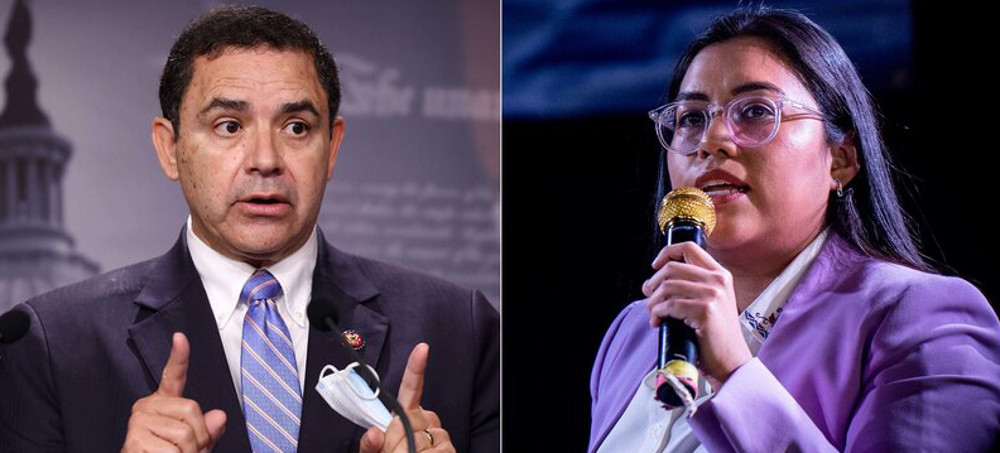 Democratic Rep. Henry Cuellar, left, and progressive candidate Jessica Cisneros. (photo: Kevin Dietsch/Getty)
Democratic Rep. Henry Cuellar, left, and progressive candidate Jessica Cisneros. (photo: Kevin Dietsch/Getty)
The Tuesday runoff contest between longtime incumbent Rep. Henry Cuellar (D-Texas) and progressive challenger Jessica Cisneros in Texas' 28th District is still too close to call as of Wednesday morning, NPR reports.
The more conservative Cuellar has held the seat since 2005, and boasts backing from a number of top House Democrats, including Speaker Nancy Pelosi (Calif.). But Cisneros is endorsed by multiple prominent progressives, including Sens. Bernie Sanders (Vt.) and Elizabeth Warren (Mass.), and Rep. Alexandria Ocasio-Cortez (N.Y.).
As of roughly 11:30 a.m. on Wednesday, the two candidates were separated by just 175 votes, with Cuellar in the lead. Despite such a narrow margin, Cuellar declared victory Tuesday night — though Cisneros declined to concede defeat. Mail-in ballots can still be counted until 5 p.m. on Wednesday, so more might come in, Forbes notes. Cisneros can also request a recount given the closeness of the race.
Important to note in the contest is the underlying issue of abortion rights, given Cuellar's status as the last anti-abortion Democrat, and the recent leak of a Supreme Court draft opinion poised to overturn Roe v. Wade.
 A sign reads "Danger Extreme Heat Conditions Ahead" in Anza-Borrego Desert State Park, which is threatened by climate change, on March 23 near Borrego Springs, Calif. (photo: Mario Tama/Getty)
A sign reads "Danger Extreme Heat Conditions Ahead" in Anza-Borrego Desert State Park, which is threatened by climate change, on March 23 near Borrego Springs, Calif. (photo: Mario Tama/Getty)
And now, scientists believe there's a correlation between hotter weather and poorer sleep in areas around the world, according to a new study.
Scientists in Denmark analyzed anonymized data from tens of thousands of smart watches and wristbands from around the world. They matched data about when people fell asleep and woke up with information about the local weather. They found that when it's hotter overnight, people have more trouble falling asleep.
The study published in One Earth notes that skin and core body temperatures become more sensitive to environmental temperatures during sleep.
The researchers say the effect of hotter temperatures on sleep is felt unequally. Older people (whose bodies don't produce enough sweat to cool their bodies), residents in lower-income countries, women, and people living in already-hot-climates feel the impact more, they say.
Scientists have found that climate change both intensifies and drives up the likelihood of heatwaves and other types of extreme weather. Climate scientists expect this to worsen as humans continue releasing heat-trapping gases into the atmosphere.
"Without further adaptation, and should greenhouse gas concentrations not be stabilized until the end of the century, each person could be subjected to an average of 2 weeks of temperature-attributed short sleep each year," the study in One Earth said.
A lack of sleep is a risk factor for physical and mental health problems including reduced cognitive performance, hypertension, compromised immune function, depression and more.
Special Coverage: Ukraine, A Historic Resistance
READ MORE
Follow us on facebook and twitter!
PO Box 2043 / Citrus Heights, CA 95611

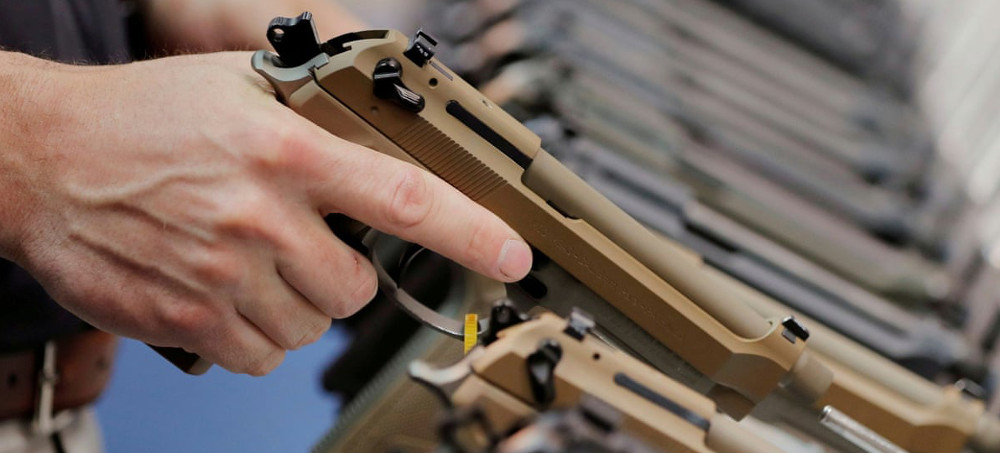

No comments:
Post a Comment
Note: Only a member of this blog may post a comment.